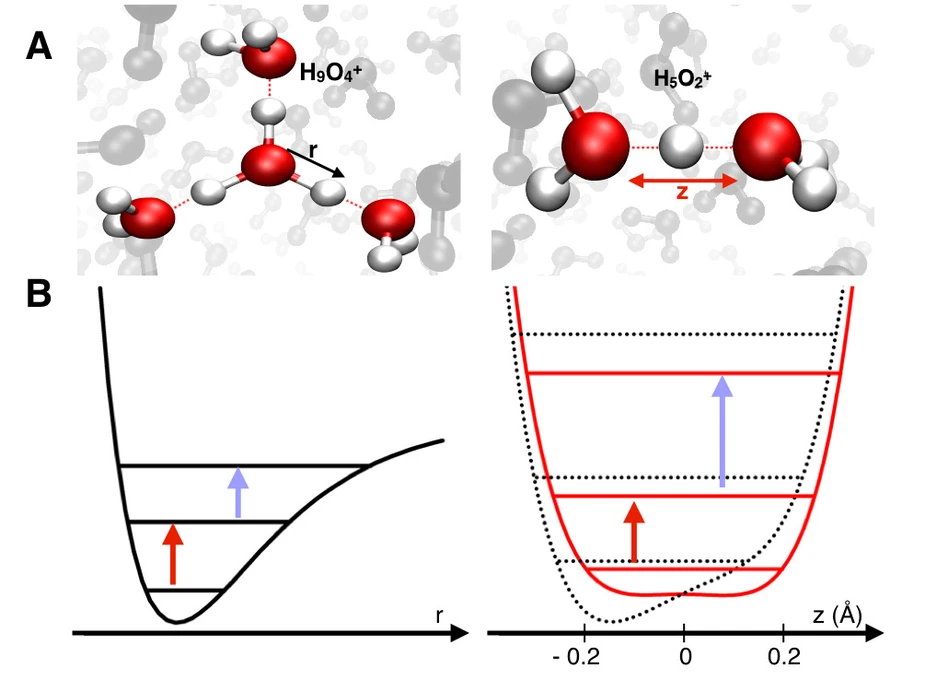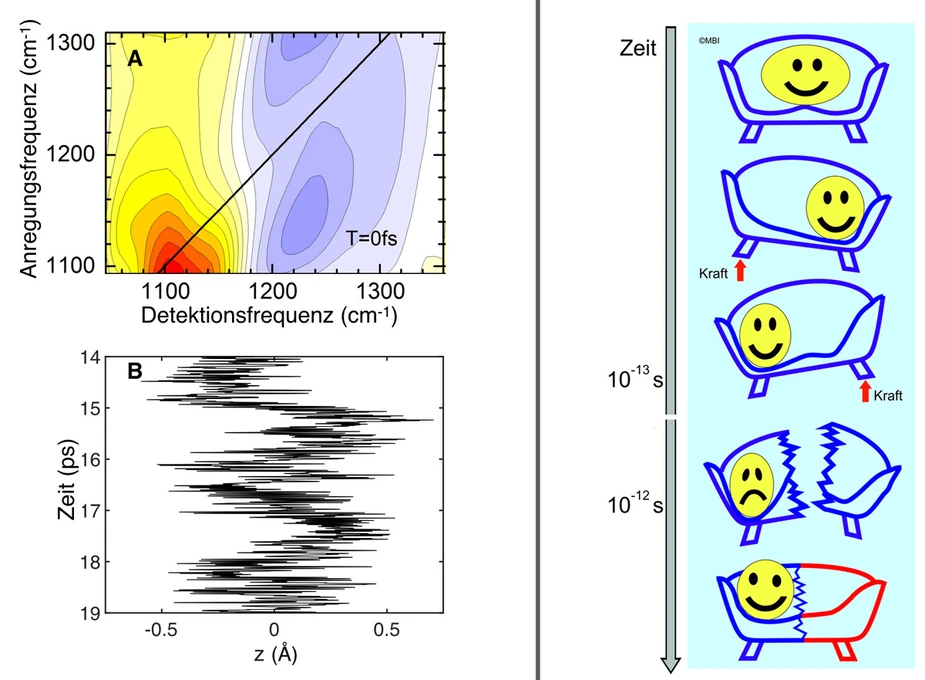Water makes the proton shake
MBI Scientists describe ultrafast motions and fleeting geometries in proton hydration
Basic processes in chemistry and biology involve protons in a water environment. Water structures accommodating protons and their motions have so far remained elusive. Applying ultrafast vibrational spectroscopy, Dahms et al. map fluctuating proton transfer motions and provide direct evidence that protons in liquid water are predominantly shared by two water molecules. Femtosecond proton elongations within a hydration site are 10 to 50 times faster than proton hopping to a new site, the elementary proton transfer step in chemistry.
The proton, the positively charged nucleus H+ of a hydrogen atom and smallest chemical species, is a key player in chemistry and biology. Acids release protons into a liquid water environment where they are highly mobile and dominate the transport of electric charge. In biology, the gradient of proton concentration across cell membranes is the mechanism driving the respiration and energy storage of cells. Even after decades of research, however, the molecular geometries in which protons are accommodated in water, and the elementary steps of proton dynamics have remained highly controversial.
Protons in water are commonly described with the help of two limiting structures (Fig. 1A). In the Eigen complex (H9O4+) (left), the proton is part of the central H3O++ ion surrounded by three water molecules. In the Zundel cation (H5O2+) (right), the proton forms strong hydrogen bonds with two flanking water molecules. A description at the molecular level employs the potential energy surface of the proton (Fig. 1B) which is markedly different for the two limiting geometries. As shown in Fig. 1B, one expects an anharmonic single-minimum potential for the Eigen species and a double minimum potential for the Zundel species. In liquid water, such potentials are highly dynamic in nature and undergo very fast fluctuations due to thermal motions of surrounding water molecules and the proton.
Researchers from the Max Born Institute in Berlin, Germany, and the Ben Gurion University of the Negev in Beer-Sheva, Israel, have now elucidated the ultrafast motions and structural characteristics of protons in water under ambient conditions. They report experimental and theoretical results in Science which identify the Zundel cation as a predominant species in liquid water. The femtosecond (1 fs = 10-15 s) dynamics of proton motions were mapped via vibrational transitions between proton quantum states (red and blue arrows in Fig. 1B). The sophisticated method of two-dimensional vibrational spectroscopy provides the yellow-red and blue contours in Fig. 2A which mark the energy range covered by the two transitions. The blue contour occurs at higher detection frequencies than the red, giving the first direct evidence for the double-minimum character of the proton potential in the native aqueous environment. In contrast, the blue contour is expected to appear at smaller detection frequencies than the red one.
The orientation of the two contours parallel to the vertical frequency axis demonstrates that the two vibrational transitions explore a huge frequency range within less than 100 fs, a hallmark of ultrafast modulations of the shape of proton potential. In other words, the proton explores all locations between the two water molecules within less than 100 fs and very quickly loses the memory of where it has been before. The modulation of the proton potential is caused by the strong electric field imposed by the water molecules in the environment. Their fast thermal motion results in strong field fluctuations and, thus, potential energy modulations on a sub-100 fs time scale. This picture is supported by benchmark experiments with Zundel cations selectively prepared in another solvent and by detailed theoretical simulations of proton dynamics (Fig. 2B).
A specific Zundel cation in water transforms into new proton accommodating geometries by the breaking and reformation of hydrogen bonds. Such processes are much slower than the dithering proton motion and occur on a time scale of a few picoseconds. This new picture of proton dynamics is highly relevant for proton transport by the infamous von Grotthuss mechanism, and for proton translocation mechanisms in biological systems.
Original publication:Science (2017) doi:10.1126//science.aan5144
Large-amplitude transfer motion of hydrated excess protons mapped by ultrafast 2D IR spectroscopy
Fabian Dahms, Benjamin P. Fingerhut, Erik T. J. Nibbering, Ehud Pines, Thomas Elsaesser
Fig. 1 Chemical structure of hydrated protons in liquid water.
A Schematic of the Eigen cation H9O4+ (left) and the Zundel cation H5O2++ (right). The arrows indicate the O-H bond coordinate r and the (O...H+...O) proton transfer coordinate z. In the Eigen cation a covalent O-H bond localizes the proton whereas in the Zundel cation the proton is delocalized between two water molecules.
B Anharmonic vibrational potential (left) and double minimum potential of the Zundel cation along z (right, red. Distortions by the solvent surrounding impose a modulation of the double minimum potential (right, dotted line). Red and blue arrows indicate transitions between particular quantum states of the proton motion , i.e., the ground-state-to-first-excited-state transition (red) and the first-excited-state-to-second-excited-state transition (blue). The modulation of the potentials leads to spectral shifts of the vibrational transitions which are mapped by two-dimensional infrared spectroscopy.
Fig 2. Femtosecond dynamics of proton motions (1 fs = 10-15 s).
A Two-dimensional vibrational spectra with the ground-state-to-first-excited-state transition (red) at lower detection frequency than the first-excited-state-to-second-excited-state transition (blue). The orientation of both contours parallel to the excitation frequency axis is due to ultrafast frequency fluctuations and the loss of memory in the proton position.
B Simulated real-time dynamics of the proton motions in the Zundel cation. Within less than 100 fs, the proton displays large amplitude excursions along z, the coordinate linking the two water molecules in the Zundel cation. Due to the ultrafast modulation of the shape of proton potential by surrounding solvent molecules, the proton explores all locations between the two water molecules.
Fig. 3. Cartoon picture of proton hydration dynamics, visualized with the help of classical physics.
The proton Smiley is sitting in the middle of a sofa with two seats. When shaking the sofa with a mechanical force, the shape of the seating changes and the proton moves forth and back on the sofa. Such motions occur on a time scale shorter than 100 fs (10-13 s). After an average time of 1 ps = 1000 fs = 10-12 s, the sofa breaks and the proton moves to a new site/sofa, including the red halve on the right.
Contact:
Max Born Institute for Nonlinear Optics and Short Pulse Spectroscopy
Prof. Thomas Elsässer, elsasser(at)mbi-berlin.de, phone +49 30 6392-1400
Dr. Benjamin Fingerhut, fingerhut(at)mbi-berlin.de, phone +49 30 6392-1404
Dr. Erik T. J. Nibbering, nibberin(at)mbi-berlin.de, phone +49 30 6392-1477
Prof. E. Pines, epines(at)bgu.ac.il, phone +972 8 6461640

